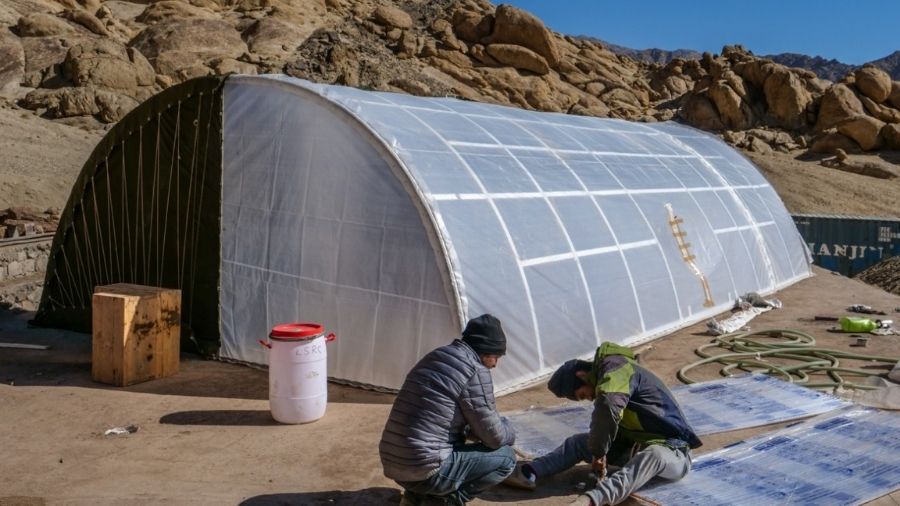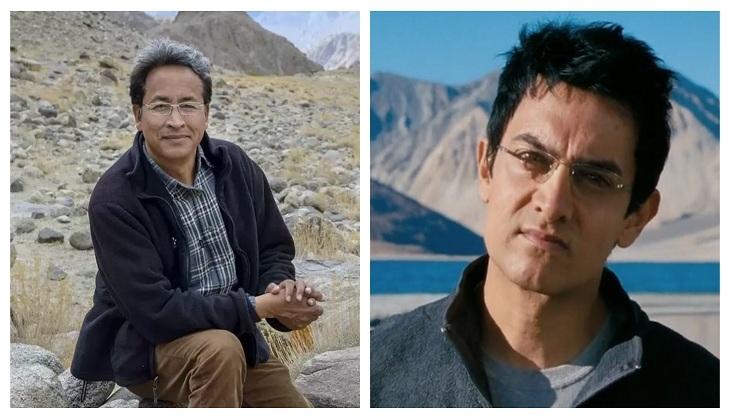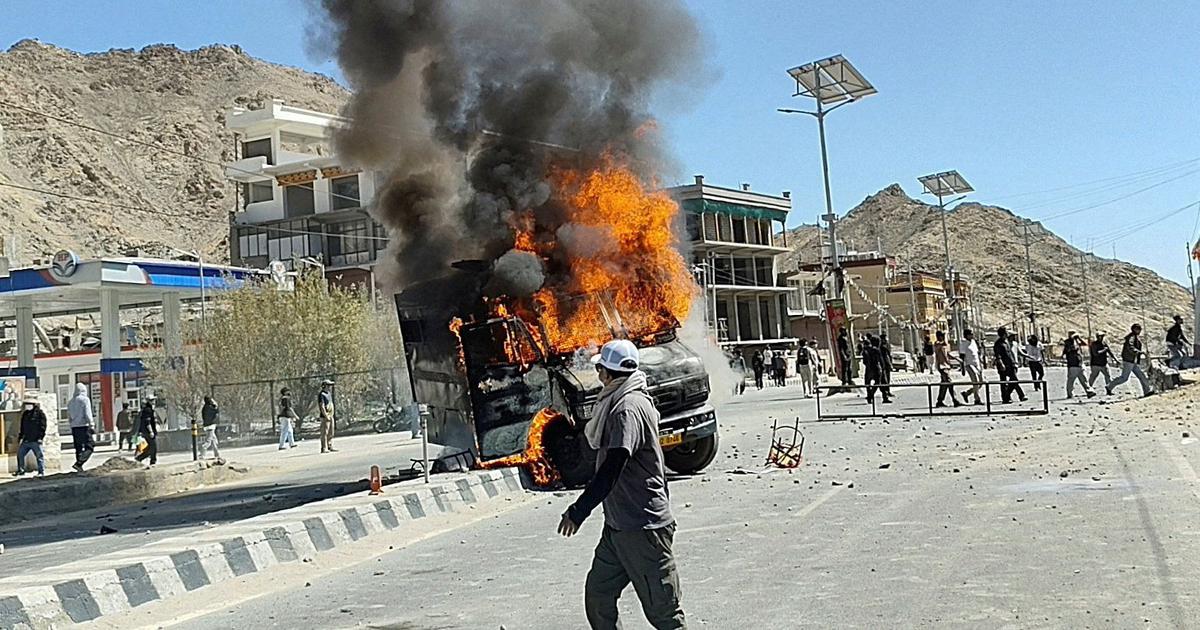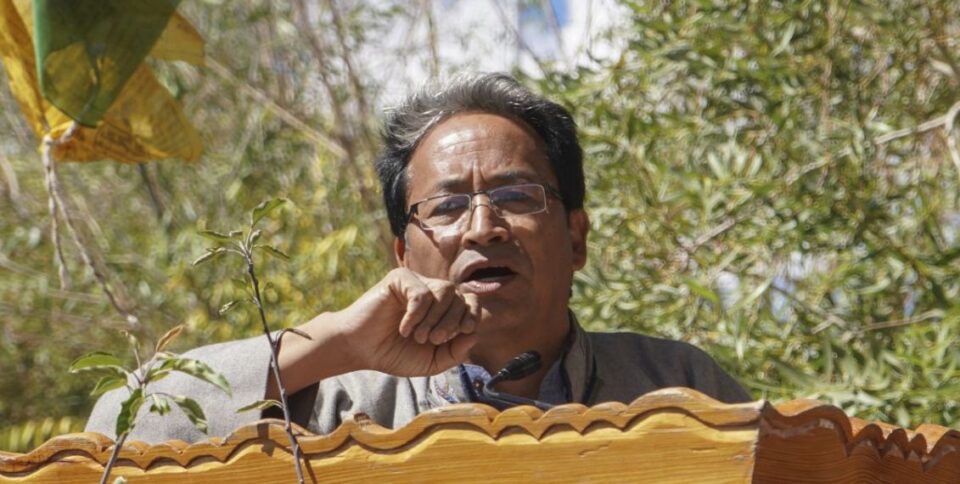Ladakh, Sonam Wangchuk: A boy who grew up in the cold mountains of Ladakh, with no formal schooling until he was nine. Home tutored by his mother and ends up being an engineer, inventor, teacher, climate activist with over 400 patents to his credit. Meet Sonam Wangchuk, who revolutionised tent life by designing solar heated tents for the India army and also the real-life inspiration for “Rancho” in the hit bollywood movie 3 Idiots, is now a detainee under National Security Act, one of the most stringent laws of India.
How a government-admired problem-solver became framed as a security risk amid Ladakh’s volatile politics and ecological anxieties?
Wangchuk created “ice stupas”- giant ice towers that store water for farmers and founded SECMOL, a school where students learn by doing, with solar-powered classrooms and lessons built for Ladakh’s tough climate. His ideas won him awards, including the Ramon Magsaysay Prize in 2018, and for years he worked with the Indian government on education, tourism, and sustainable living.

But today, this peaceful innovator is behind bars. Arrested under the National Security Act after protests in Leh turned violent on September 24, 2025, Wangchuk now sits in a high-security jail in Jodhpur. His wife has pleaded with the President for his release, saying the family is being harassed.
How did a man who built solutions for his people end up in chains for demanding rights and climate protection for Ladakh?
An Unconventional, Real life to Reel Hero
Wangchuk’s popular image stems from his role inspiring “Rancho”- the curious, hands-on problem-solver, owing to decades of work in alternative education and frugal innovation for Himalayan life, including SECMOL and later HIAL, where practice-led learning and appropriate technology are central.

Over the years, government agencies repeatedly sought his advice on water, clean energy, and high-altitude tourism, reflecting his stature as a policy-facing expert even as he campaigned for Ladakh’s fragile ecology and community rights. That duality – insider advisor and outsider agitator, framed the arc that now makes his detention so contentious.
The demands for Ladakh
Following the 2019 reorganization of Jammu and Kashmir and Ladakh, Wangchuk helped crystallize four core demands: statehood for Ladakh, inclusion under the Sixth Schedule for tribal protections, a dedicated public service commission, and safeguards for land and jobs, often articulated under the Leh Apex Body (LAB) umbrella.
These demands aimed to balance strategic border imperatives with democratic representation and ecological guardrails in a region acutely vulnerable to climate change and unregulated development, which Wangchuk has repeatedly warned against in public appeals and fasting campaigns. The Centre acknowledged dialogue windows, but talks were intermittent and increasingly strained as rhetoric hardened on both sides through 2024–25.
The hunger strikes, timeline, and escalation
-
In October 2024, after a Padyatra-related detention episode, he launched a 16-day fast that ended when the Home Ministry assured talks in December, which briefly de-escalated tensions while keeping the agenda alive.
-
On September 10, 2025, he began a planned 35-day fast in Leh, invoking Gandhian means to press for renewed talks on statehood and Sixth Schedule; national solidarity groups traveled to Ladakh, swelling the movement’s visibility.
-
On September 24, protests turned violent in Leh: four people died, over 80 were injured, public property including the local BJP office and vehicles were torched, and curfew plus internet suspension followed; authorities blamed Wangchuk’s speeches for inflaming the crowd, a claim his supporters contest.
The arrest under NSA
Two days after the violence, police detained Wangchuk under Section 3(2) of the National Security Act, transferring him to Jodhpur Central Jail, invoking national security to justify preventive detention without immediate trial; prison officials placed him in a high-security environment with layered surveillance, highlighting the severity of the state’s perception of risk.

The Ladakh administration said the action was based on “credible inputs and documents,” called allegations of a witch hunt unfounded, and linked responsibility to “provocative” mobilization even after a government-proposed meeting date had been announced, a sequence they argue contributed to breakdown of order on September 24.
The DGP’s remarks flagged “provocative” references to foreign protest movements and said possible “links” were under scrutiny, assertions Wangchuk’s camp rejects as defamatory and chilling to dissent.
Wife’s plea to the President
In a detailed representation to the President of India also copied to the Prime Minister and Home Minister, Wangchuk’s wife, Dr. Gitanjali J Angmo, sought his unconditional release, calling him a peaceful Gandhian protestor with an impeccable record of service, including building warm shelters for soldiers in extreme frontiers. She wrote that the family was not allowed to speak with him after detention and that their institute came under heavy surveillance with demands for staff and student details, which she termed a “full-scale witch hunt” that violates the spirit of Articles 21 and 22 on due process and legal representation. Appealing to the President’s tribal background, she framed the movement as one for constitutional protections for a tribal belt, warning that treating Ladakh’s “son of the soil” as a threat undermines border solidarity and democratic cohesion in a sensitive frontier.
Government’s version and fact-checks
The Ladakh administration insists there is no witch hunt, saying detention grounds were served and investigations should proceed impartially; they point to continued agitation and the September 24 breakdown to justify the NSA invocation while rejecting claims of politically directed action without evidence. The government’s fact-check machinery also pushed back on viral content, labeling alleged claims about political orders for arrest as fake or deepfake-linked, underscoring the information-war dimension over what happened and why. Official communications acknowledged his September 10 hunger strike and the stated demands, but maintain that law and order failures and alleged incitement necessitated hard measures under national security law.
Advisor to ‘threat’: a paradox
Indian Express chronicled how ministries and agencies once tapped Wangchuk as an “expert for all seasons” from ice stupas and glacier-aware water design to high-altitude housing and sustainable tourism only for him to be designated a threat under the NSA after unrest spiraled, sharpening questions about the boundary between policy critique, mass mobilization, and security. This juxtaposition has energized support among civil society groups who see his detention as punitive overreach and a “smokescreen” to delegitimize ecological and constitutional demands, even as the administration argues the threshold of public safety was crossed.
Climate activism and ecological stakes
For a decade, Wangchuk has tied Ladakh’s climate vulnerability rapid glacier retreat, water scarcity cycles, fragile high-altitude biomes to governance design, advocating constitutional protections to ensure community-centric and ecology-first development. His innovations, like ice stupas and passive solar habitats, were paired with mass pedagogy and citizen science at SECMOL and HIAL, a blend that made him both a local hero and a national symbol of frugal innovation in the climate age.
As protests grew, he increasingly warned that ignoring environmental limits while pushing extractive growth would ignite social flashpoints warnings that now read as both prescient and politically combustible after the September violence.
The movement’s present fault lines
-
The Leh Apex Body reportedly distanced itself from dialogue after “anti-national” labels, insisting on accountability and judicial scrutiny before returning to talks, thereby hardening the standoff in the immediate aftermath of arrests and curbs.
-
A timeline of the last twelve months shows repeated cycles: fasts, tentative assurances, new mobilizations, and finally a sharp descent into violence, followed by the cancellation of SECMOL’s FCRA registration and then the NSA detention, which activists read as a state message to broader movements across the Himalaya.
-
Meanwhile, even attempts by public representatives to meet Wangchuk in prison faced restrictions, amplifying concerns from supporters about transparency and due process during preventive detention.
Detention, process, and rights
Preventive detention under the NSA allows up to a year of detention without standard trial processes, with executive orders grounded in national security or public order concerns; critics argue it casts a vast shadow over civil liberties and dissent, especially in moments of post-violence crackdown. Angmo’s letter spotlights alleged denial of contact, legal clarity, and institutional pressure on HIAL, framing these as violations that compound the injustice of NSA use against a nonviolent climate activist; the administration’s stance is that the gravity of the unrest and “credible inputs” justify the steps taken so far. Fact-check units have simultaneously tried to sanitize the discourse by quashing viral misinformation about alleged political directives, underscoring the contested narrative terrain around his detention.
The politics of labeling ‘threat’
“National threat” is the charged phrase now stapled onto a figure who, until recently, was routinely showcased as a model Indian innovator, Magsaysay laureate, and enabler of field-tested solutions in the Himalaya an arc captured by national media as a symbol of India’s own ambivalence about dissenting experts.
Supporters say Wangchuk’s lifework like educating rural youth, creating climate-adaptive technologies, and promoting democratic protections demonstrates patriotism, not subversion; the Ladakh administration replies that responsibility for violence, incitement, and public order lapses cannot be papered over by past laurels or framing as Gandhian protest.
The truth and the ultimate legitimacy of the NSA detention will hinge on evidence, judicial oversight, and whether the political system can separate lawful dissent and ecological advocacy from agitational flashpoints in a borderland under stress.
Where things stand now
As of this week, Wangchuk remains in Jodhpur Central Jail under NSA, with the administration defending the detention and widening its probe, and his wife pressing the President for intervention and unconditional release, alleging surveillance and denial of basic rights like family contact and counsel access.
Media timelines record a swift chain: renewed fast from September 10, violent protests on September 24 with four dead and over 80 injured, FCRA cancellation for SECMOL on September 25, and NSA detention with transfer out of Ladakh on September 26, followed by tightened curbs and continuing political fallout in Leh.
Meanwhile, government fact-checks push back on viral claims, and the administration calls for allowing impartial investigation, even as civil society voices and opposition figures frame the case as a defining test of democratic space for climate and tribal rights activism in the Himalaya.
The “Rancho” archetype that once warmed national pride now sits uneasily beside a solitary cell in a desert prison, the ironies heightened by his own innovations for soldiers enduring Himalayan cold, and by his long insistence that stronger democracy and ecological prudence are the surest strategies for secure borders.
Whether the state can contain Ladakh’s anger by force while addressing core demands remains open, as does the question of whether a figure like Sonam Wangchuk is best engaged as a partner in solutions or fixed as an example of overreach in the age of preventive detention. In the days ahead, the judiciary, the tenor of dialogue, and the handling of evidence will decide if this chapter becomes a cautionary tale about dissent and security in the Anthropocene , or a pivot back to a politics of problem-solving guided by trust, rights, and climate reality.

